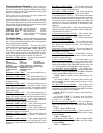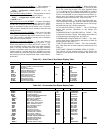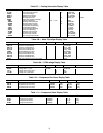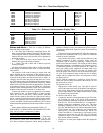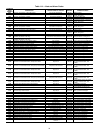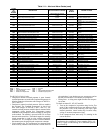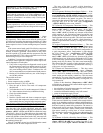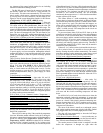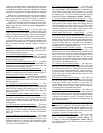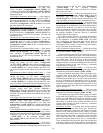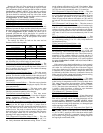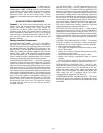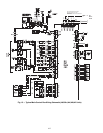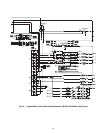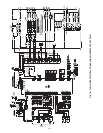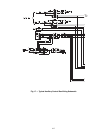
98
compressor is brought on and 5 seconds afterwards. The rate of
suction pressure change from 5 seconds before the compressor
is brought on to when the compressor is brought on is calculat-
ed. Then the rate of suction pressure change from when the
compressor is brought on to 5 seconds afterwards is calculated.
With the above information, the test for reverse rotation is
made. If the suction pressure change 5 seconds after compres-
sion is greater than the suction pressure change 5 seconds be-
fore compression – 1.25, then there is a reverse rotation error.
This alarm will disable mechanical cooling and will require
a manual reset. This alarm may be disabled once the reverse
rotation check has been verified by setting Configuration
COOL
REV.R = Yes.
A150 (Unit is in Emergency Stop)
— If the fire safety input
condition occurs to indicate a fire or smoke condition, then
Alarm code 150 will occur and the unit will be immediately
stopped. Through separate inputs the unit can be put into purge,
evacuation, and pressurization. This requires a manual reset.
If the CCN point name “EMSTOP” in the System table is
set to emergency stop, the unit will shut down immediately and
broadcast an alarm back to the CCN indicating that the unit is
down. This alarm will clear when the variable is set back to
“enable.”
T153 (Real Time Clock Hardware Failure)
— A problem has
been detected with the real timeclock on the MBB. Try reset-
ting the power and check the indicator lights. If the alert contin-
ues, the board should be replaced.
A154 (Serial EEPROM Hardware Failure)
— A problem has
been detected with the EEPROM on the MBB. Try resetting
the power and check the indicator lights. If the alarm continues,
the board should be replaced.
T155 (Serial EEPROM Storage Failure Error)
— A problem
has been detected with the EEPROM storage on the MBB. Try
resetting the power and check the indicator lights. If the alert
continues, the board should be replaced.
A156 (Critical Serial EEPROM Storage Failure Error)
— A
problem has been detected with the EEPROM storage on the
MBB. Try resetting the power and check the indicator lights. If
the alarm continues, the board should be replaced.
A157 (A/D Hardware Failure)
— A problem has been detected
with A/D conversion on the boards. Try resetting the power
and check the indicator lights. If the alarm continues, the board
should be replaced.
A171 (Staged Gas Control Board Comm Failure)
— This
alarm indicates that there are communications problems with
the staged gas heat control board, which is located in the gas
section on units equipped with staged gas heat. If this alarm
occurs, the staged gas heat will be disabled. The alarm will
automatically reset.
A172 (Controls Expansion Module Comm Failure)
— This
alarm indicates that there are communications problems with
the controls expansion board. All functions performed by the
CEM will stop, which can include demand limit, reset, fire
control modes, and the fan status switch. The alarm will auto-
matically reset.
A173 (ECB1 Board Communication Failure)
— This alarm
indicates that there are communications problems with the
economizer control board. This will result in the economizer
and the power exhaust not working and the dampers to be fully
closed. The exhaust fans will stop. The alarm will automati-
cally reset.
A174 (ECB2 Board Communication Failure)
— This alarm
indicates that there are communications problems with the
ECB2 which controls the VAV unit indoor fan inverter speed
and hot gas bypass on CV and VAV units. Because the control
of the fan is critical to unit operation, the unit will be stopped.
The alarm will automatically reset.
T177 (4-20 mA Demand Limit Failure)
— This alert indi-
cates a problem with the optional remote 4 to 20 mA demand
limit signal (Inputs
4-20
DLM.M) that is connected to the
CEM module (if the signal reads less than 2 mA). If this
occurs, then demand limiting will be disabled. The unit must
be configured for 4 to 20 mA Demand Limiting using the
Demand Limit Select (Configuration
DMD.L
DM.L.S).
T178 (4-20 mA Static Pressure Reset/VFD Failure)
— If this
transducer fails (if the signal reads less than 2 mA on the input
of the CEM module), and the unit is configured to perform
static pressure reset or remote control of the supply fan VFD
with this transducer, no static pressure reset or VFD control
will be performed and an alert will be generated. Recovery is
automatic. Reason for error is either a faulty sensor, wiring
error, or damaged input on the CEM control board.
A200 (Linkage Timeout Error — Comm Failure)
— If link-
age is established via the CCN with ComfortID™ terminals, a
5-minute timeout on loss of communication will be monitored.
If 5 minutes expires since the last communication from a VAV
Linkage Master, the unit will remove the link and flag the alert.
When the rooftop looses its link, the temperature and set points
are derived locally. Recovery is automatic on re-establishment
of communications. Reason for failure may be wiring error, too
much bus activity, or damaged 485 drivers.
T210 (Building Pressure Transducer Failure)
— The building
pressure transducer (Pressures
AIR.P
BP) fails if the
signal from the 4 to 20 mA building pressure transducer (used
to control the power exhaust fans and the building pressure) is
below 2 mA. If the alert occurs, then the economizer will be
closed and the power exhaust fans turned off. This alert will
automatically reset. Check the building pressure transducer and
sensor tubing. The sensor is located in the auxiliary control
box. The alert will automatically reset.
T211 (Static Pressure Transducer Failure)
— The static pres-
sure transducer (Pressures
AIR.P
SP) fails if the signal
from the 4 to 20 mA static pressure transducer (used to control
the VFD speed) is below 2 mA. This failure will cause the unit
to stop due to the potential damage that could occur due to
over-pressurization. Check the pressure transducer and sensor
tubing. The sensor is located in the auxiliary control box. The
alert will automatically reset.
T220 (Indoor Air Quality Sensor Failure)
— The indoor air
quality sensor (Inputs
AIR.Q
IAQ) fails if the signal from
the 4 to 20 mA sensor is below 2 mA. If the indoor air quality
sensor fails, demand control ventilation is not possible. The
control defaults to the maximum vent position. Recovery is au-
tomatic. Reason for error is either a faulty sensor, wiring error,
or damaged input on the MBB control board.
T221 (Outdoor Air Quality Sensor Failure)
— The indoor air
quality sensor (Inputs
AIR.Q
OAQ) fails if the signal from
the 4 to 20 mA sensor is below 2 mA. If the outdoor air quality
sensor fails, OAQ defaults to 400 ppm and demand control
ventilation will continue. Recovery is automatic. Reason for
error is either a faulty sensor, wiring error, or damaged input on
the CEM control board.
T229 (Economizer Minimum Position Override Input Fail-
ure) — If the unit is configured to use the remote position
override for the economizer and the input Econo Min. Pos.
Override (Configuration
IAQ
AQ.SP
IQ.O.P) input 4 to
20 mA reading is less than 2 mA then an alert will occur and
the default software minimum position will be used for the
economizer. The alert will automatically reset.
T300 (Space Temperature Below Limit)
— If the space tem-
perature is below the configurable SPT Low Alert
Limits (occupied [Configuration
ALLM
SP.L.O] for
5 minutes or unoccupied [Configuration
ALLM
SP.L.U]
for 10 minutes), then an alert will be broadcast. The alert will
automatically reset.



